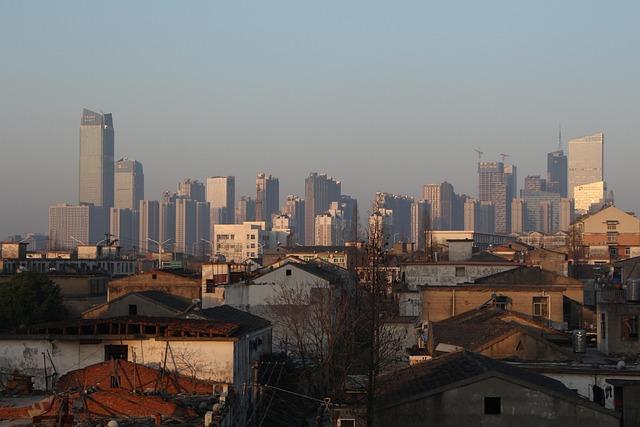Hefei, the capital of Anhui Province, has officially joined the ranks of China’s major urban centers as the nation’s 18th city to surpass a population of 10 million permanent residents. This significant demographic milestone marks a notable chapter in Hefei’s rapid urbanization and economic development, reflecting both the challenges and opportunities faced by cities navigating the pressures of growth in a rapidly changing social landscape. As one of the key players in the Yangtze River Delta region, Hefei’s surge in population underscores its rising prominence as a hub for technology, education, and innovation. In this article, we explore the implications of Hefei’s expanding populace and the factors contributing to its evolution into a metropolitan powerhouse.
Hefei’s Population Surge and Its Implications for Urban Development
Hefei’s recent milestone of surpassing 10 million permanent residents reflects a significant demographic shift that is likely to reshape its urban landscape. The influx of residents has brought about a variety of challenges and opportunities for city planners and stakeholders. As the population grows, the demand for essential services, infrastructure, and housing has intensified, prompting local authorities to explore innovative solutions for sustainable urban development. Key areas of focus include:
- Transportation Networks: Expanding public transit options to alleviate traffic congestion and improve accessibility.
- Green Spaces: Preserving and enhancing parks and recreational areas to foster community well-being.
- Affordable Housing: Developing plans to accommodate the rising demand for housing without compromising affordability.
In response, Hefei’s government is implementing strategic policies aimed at promoting responsible growth. This includes investing in smart city technologies that streamline urban management and improve living standards. Enhancing educational institutions and healthcare facilities is equally crucial to support the growing population. A recent analysis of Hefei’s development initiatives has highlighted the following priorities:
| Development Focus | Objective |
|---|---|
| Infrastructure Expansion | Strengthen connectivity throughout the city. |
| Environmental Sustainability | Reduce the urban carbon footprint. |
| Smart Technology Integration | Enhance data-driven decision making for urban planning. |
Exploring the Economic Impact of Hefei’s Growing Demographics
Hefei’s rapid demographic growth to 10 million permanent residents marks a significant milestone, not only for the city but also for the broader regional economy. This transformation has been fueled by an influx of both local and migrant populations, spurred by job opportunities in high-tech industries and education. As a result, the city is witnessing a booming service sector, an uptick in consumer spending, and vibrant real estate development. The city’s investment in infrastructure, such as transportation and housing, further supports its economic expansion, creating a synergistic effect that attracts even more residents and businesses.
Furthermore, the growing populace is altering the demographic landscape, leading to shifts in consumer behavior and market demands. Key sectors such as technology, education, and healthcare are experiencing unprecedented growth. Major initiatives are being rolled out to cater to this rising demand, including:
- Expansion of educational institutions to accommodate a younger population eager for advanced learning.
- Investment in healthcare facilities to ensure the well-being of an increasing number of residents.
- Enhancements in public transportation to better connect neighborhoods and reduce congestion.
| Sector | Projected Growth (%) |
|---|---|
| Technology | 15 |
| Healthcare | 12 |
| Education | 10 |
| Real Estate | 8 |
This demographic boom presents unique challenges and opportunities; local authorities and businesses will need to adapt quickly to the evolving landscape to harness the benefits of a diverse and growing population. Strategic planning and investment are essential for ensuring that Hefei not only maintains its growth trajectory but also improves the quality of life for its residents.
Strategic Recommendations for Sustainable Growth in Hefei’s Urban Landscape
As Hefei embraces its new status as a city with a permanent resident population of over 10 million, strategic planning and policy implementation become paramount for sustainable urban development. Key recommendations for city officials and stakeholders include:
- Investment in Public Transportation: Enhancing the efficiency and reach of public transport systems can reduce traffic congestion and improve air quality.
- Green Spaces Development: Expanding parks and recreational areas will not only beautify the city but also serve as crucial urban lungs contributing to residents’ well-being.
- Sustainable Housing Initiatives: Encouraging green building practices and affordable housing projects will ensure that growth meets the needs of the population without sacrificing environmental integrity.
- Revitalization of Urban Centers: Focusing on mixed-use developments in underutilized areas can stimulate local economies and foster vibrant communities.
To effectively track the progress and impact of these initiatives, establishing a comprehensive data management framework is essential. Below is a simplified overview of potential focus areas and their corresponding goals:
| Focus Area | Goals |
|---|---|
| Public Transportation | Reduce average commute times by 20% within 5 years |
| Green Spaces | Increase green space per capita by 30% by 2030 |
| Sustainable Housing | Ensure 50% of new builds are eco-friendly within the next decade |
| Urban Revitalization | Revamp at least 5 key districts to boost local businesses |
The Way Forward
In conclusion, Hefei’s milestone of surpassing 10 million permanent residents marks a significant chapter in the city’s rapid development and urbanization. This achievement not only emphasizes Hefei’s status as a pivotal hub in eastern China but also reflects broader trends in population migration and economic growth across the nation. As the city continues to evolve, it faces both challenges and opportunities in managing its expanding urban landscape. From infrastructure development to sustainability initiatives, Hefei’s experience may serve as a valuable case study for other burgeoning metropolitan areas in China and beyond. As this dynamic city advances, all eyes will be on its journey to balance growth with quality of life for its residents in the years to come.
